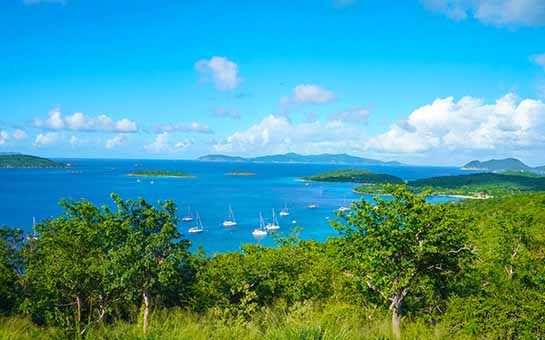Virgin Islands National Park is a US National Park in the United States territory of the US Virgin Islands. The 15,000-acre park covers the majority of Saint John and Hassel Island along with the surrounding ocean. It’s popular for its incredible white sand beaches, tropical hiking, and endless snorkeling opportunities.
If you’re ready to see the Caribbean in its natural state, read on. Discover Virgin Islands National Park, and the visitors medical insurance you need to visit it.
Visitors Medical Insurance for Travelers visiting Virgin Islands National Park – FAQs
The natural beauty of Virgin Islands National Park has hidden dangers. Sweltering heat, strong currents, sharp coral, and poisonous plants could all lead to an unexpected injury or illness. You could just as easily break a bone on the trail. You’ll need to have a way to get necessary medical care for a price you can afford. You’ll need visitors medical insurance.
Do I need visitors medical insurance for Virgin Islands National Park?
Foreign tourists aren’t legally required to have visitors medical insurance to enter US territories, but it’s a smart thing to have. If you don’t have it, you’ll be stuck paying the full cost of any medical treatment you need out of your own pocket.
Why buy visitors medical insurance before visiting Virgin Islands National Park?
You can say that you’ll be careful, or that it’s unlikely that you’ll get sick or hurt while visiting Virgin Islands National Park. But unexpected medical issues are just that: unexpected. You need health insurance that will be accepted in the US Virgin Islands in order to get care for a predictable price. This is why visitors medical insurance is so important for any foreign visitor.
Virgin Islands National Park’s Most Popular Activities
Whether you’re on land or in the water, Virgin Islands National Park offers plenty to do. Check out these activities while you’re here.
Snorkeling
Nearly half Virgin Islands National Park is below the surface of the water. Strap on your mask and flippers and get to exploring! You can see coral reefs, mangrove shorelines, beds of seagrass, and all manner of sea life. Many popular snorkeling areas are accessible via road or hiking trail, and different areas suit snorkelers of varying abilities. Get a park map before you head out to find the perfect snorkeling spot for you.
Beautiful Beaches
Beaches abound in Virgin Islands National Park. Walk the white sands next to Salomon/Honeymoon Bay, see if you can spot the sea turtles from the beach in Maho Bay, or watch the sailboats from the narrow beach above Watermelon Cay. Whether you use them as basecamps for snorkeling or just as picturesque places to relax, the beaches of Virgin Islands National Park are among the best in the world.
Hiking
There are more than 20 hiking trails in Virgin Islands National Park. They range from accessible boardwalks running next to historic ruins all the way to strenuous treks through the jungle that can take upwards of four hours. Along the trail you can see the remnants of ancient Danish sugar plantations, prehistoric rock carvings, and absolutely jaw-dropping views of the waters below.
Boating
Experienced mariners can take to the water to see marine life and fantastic views all around Virgin Islands National Park. In fact, a boat is one of the easiest ways to access much of the park. However, it’s extremely important to pay the necessary fees and download the right maps so you know where you can moor or anchor your boat, as well as which beaches permit boat access.
Exploring the Ruins
Annaberg Plantation was once located in what is now Virgin Islands National Park. This sugar plantation was home to over 600 enslaved persons, many who used Leinster Bay to escape to the nearby British Virgin Islands. You can still see the ruins of the old windmills and animal mill, and the sleeping quarters of the men, women, and children who worked at the plantation.
Key Guidelines for Visitors to Virgin Islands National Park
When to Visit
Virgin Islands National Park is open 24 hours a day, 7 days a week, and 365 days a year. However, certain areas like the visitor center, Trunk Bay, and other park facilities have specific operating hours and may be closed on certain holidays.
Hiking Tips
The National Park Service warns hikers at Virgin Islands National Park to always bring a map, and pack at least half a gallon of water for every four hours they will be on the trail. Visitors are also urged not to handle or eat plants or berries along the trail. Some may cause rashes if touched, and others are poisonous.
If You Plan to Camp
Please note that camping in Virgin Islands National Park is only allowed in designated areas of Cinnamon Bay Beach and Campground, and that reservations are required to camp here.
Tropical Storm Safety
Due to its Caribbean location, Virgin Islands National Park can be struck by tropical storms and hurricanes. Atlantic hurricane season is typically most active from August through November, but tropical storms are possible year-round. Keep a close watch on tropical weather forecasts before planning your trip.
Parking at the Park
Although public parking is available at Virgin Islands National Park, it is very limited, and parking lots usually fill up early in the morning. Park officials recommend taking a safari taxi from your hotel to the park, and scheduling a time for them to pick you up and return you in advance. If you do decide to drive, make sure you have an NPS Parking Permit for the vehicle.
Before You Visit Virgin Islands National Park – Do This
- Pack ample water and plenty of sunscreen.
- Make reservations if you intend to camp.
- Purchase visitors medical insurance .
